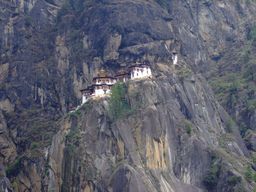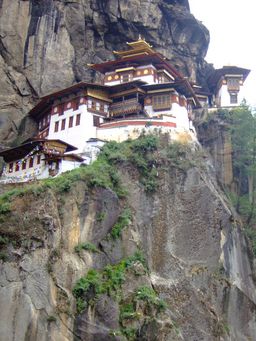Difference between revisions of "Paro Taktsang"
m |
(merged contents of Paro Taksang here) |
||
| Line 1: | Line 1: | ||
| − | [[ | + | Paro Taktsang ''([[spa phro stag tshang]])'' / ''([[spa gro stag tshang]])'' / ([[spa gro stag tshang bsam grub ke'u tshang]]) |
| + | ---- | ||
| − | [[ | + | One of the thirteen taktsang, or "Tiger Lair", sacred caves in Tibet and Bhutan blessed by [[Guru Padmasambhava]] and seventh of the [[Eight Sacred Places|eight sacred places]] in Tibet and Bhutan he blessed for the practice of the [[Eight Classes of Herukas]] ([[sgrub pa bka' brgyad]]). In particular this is the place related to Jigten Chöto ([['jigs rten mchod bstod]]), where [[Palgyi Senge of Lang| Langchen Palseng]] ([[rlangs chen dpal seng]]), attained realization. |
| − | [[spa gro stag | + | * [[spa gro stag tshang]] - Padro Tagtshang which is a meditation place in Bhutan [JV] |
| + | * [[spa gro stag tshang bsam grub ke'u tshang]] - Paro Taktsang, in Bhutan [RY] | ||
| − | |||
| − | |||
| − | [[ | + | ==Visit of [[Padmasambhava]]== |
| + | [[Image:ParoTaksang-01.jpg|thumb|256px|right|'''Paro Taksang''']]<br> | ||
| + | In the 8th Century CE Guru Rinpoche visited Bhutan and blessed it as the second Kailash. At that time malignant spirits abounded and, in order to subdue them, he assumed the terrifying form of [[Guru Dorje Dröllo]] one of the [[Eight Manifistations of Guru Rinpoche]] ([[gu ru mtshan brgyad]]) and consecrated Paro Taksang as a sacred site to protect the Dharma and subdue harmful forces. | ||
| − | + | ==Visit of [[Langchen Palgyi Senge]]== | |
| + | While confering the empowerments of the [[Eight Classes of Herukas]] Cycle to the [[Twenty-five Disciples]] at [[Yamalung]], Guru Rinpoche instucted [[Langchen Palgyi Senge]] (rlangs chen dpal gyi seng ge) to carry out the practice of the Fierce Mantra of the Tamer of All Haughty Spirits at Taksang Senge Samdup in the Paro valley of Bhutan. | ||
| − | + | In accordance with these instructions Langchen Palgyi Senge came to Paro Taksang in 853 CE meditating until he accomplished the practice of the Tamer of All Haughty Spirits gaining profound siddhi which enabled him to bind gods and spirits to his service. | |
| − | + | The cave in which he meditated became known as Pelphug or Drubphug. | |
| − | + | ==The nine sacred caves at Paro Taksang== | |
| + | * '''[[Machig Phug, Paro|Machig Phug]]''' (ma gcig phug) - the cave where [[Machik Labdron]] meditated. <br> | ||
| + | * '''[[Senge Phug, Paro|Senge Phug]]''' (sen ge phug)- the cave where Guru Rinpoche meditated on [[Vajra Kilaya]]. <br> | ||
| + | * '''Pelphug''' (dpal phug) - the cave where [[Guru Rinpoche]] meditated for four months on phur pa'i lha tshogs and <br> | ||
| + | * '''Drolo Phug''' (gro lod phug)<br> | ||
| + | * '''Osel Phug''' ('od gsal phug)<br> | ||
| + | * '''Gedig Phug''' (dge sdig phug)<br> | ||
| + | * '''Chogyal Phug''' (chos rgyal phug)<br> | ||
| + | * '''Kapali Phug''' (ka pa li phug)<br> | ||
| + | * '''Phagmo Phug''' (phag mo phug)<br> | ||
| + | [[Image:ParoTaksang-03.jpg|thumb|256px|right|'''Paro Taksang''']] | ||
| − | + | =='''Lhakhang'''== | |
| + | There are seven chapels within the present temple complex: | ||
| + | * '''Drubkhang''' (sgrub khang)<br> | ||
| + | * '''Chapel of the Speaking Guru''' (gu ru gsung byon ma'i lha khang)<br> | ||
| + | * '''Dröllo Lhakhang''' (gro lod lha khang)<br> | ||
| + | * '''Chapel of Amitayus''' (rtse dpag med lha khang)<br> | ||
| + | * '''Chapel of Vaishravana''' (rnam sras lha khang)<br> | ||
| + | * '''Shrine room of Nedag Senge Samdup''' (seng ge bsam grub gnas khang) <br> | ||
| + | * '''Chapel of [[Marpa]], [[Milarepa]] and [[Gampopa]]''' (mar mi dvags sum lha khang)<br> | ||
| − | |||
| − | + | ==Consruction of Temple== | |
| − | + | The first known temple at Taksang Pelphug was built in about c. 1508 by Sonam Gyaltsen a Nyingma lama belonging to the Kathog lineage who was invited from Tibet by Taksang Lama Nganggyu (ngang rgyud). Lama Sonam Gyaltsen resided at nearby [[Urgyen Tsemo]] temple above Taksang, which had been established by his uncle Yeshi Bunpa (). Sonam Gyaltsen transmitted 46 volumes of the Nyinma Gyudbum to his disciples. Taksang remained in the care of his family lineage until the 17th Century. | |
| − | + | In 1645 [[Shabdrung Ngawang Namgyal]] with his Nyingma teacher Rigdzin Nyingpo, a descendant of [[Terton Sangye Lingpa], and the temple was offered to him. | |
| − | [[ | + | Construction of a large Lhakhang at Taksang Pelphug was begun by Shabdrung Rinpoche's successor [[Gyalse Tenzin Rabgye]] in 1692. The construction was supervised by the artisan Grags-pa rGya-mtsho. |
| + | Sacred images were made by the Newar artists Pañca Deva, Darma Deva and Darma Shrī. | ||
| + | |||
| + | ==Fires and Restoration== | ||
| + | |||
| + | ==Alternate Names & Spellings== | ||
| + | * Padro Taksang ([[spa gro stag tshang]]) | ||
| + | * Paro Taksang ([[spa phro stag tshang]]) | ||
| + | * [[Paro Taktsang]] | ||
| + | * Taksang Senge Samdup ([[stag tshang seng ge bsam grub]]) | ||
| + | * Taksang Pelphug | ||
| + | * [[spa gro stag tshang bsam grub ke'u tshang]] | ||
| + | |||
| + | ==References== | ||
| + | * John A. Ardussi: [http://orion.lib.virginia.edu/thdl/texts/reprints/jbs/JBS_01_01_02.pdf| Gyalse Tenzin Rabgye and the Founding of Taktsang Lhakhang]. Journal of Bhutan Studies, 1:1, 1999<br> | ||
| + | * ''Guide to Taktshang'' (གནས་ཆེན་སྟག་ཚང་ལམ་འཁྲིད)/ ''Restored Taktshang'' (ཉམས་གསོ་ཞུགས་པའི་སྟག་ཚང་), Department of Culture, Thimphu, Bhutan 2005. ISBN 9993661716 | ||
| + | |||
| + | ==External Links== | ||
| + | * <br> | ||
| + | |||
| + | [[Category:Sacred Sites in Bhutan]] | ||
Revision as of 03:53, 19 August 2008
Paro Taktsang (spa phro stag tshang) / (spa gro stag tshang) / (spa gro stag tshang bsam grub ke'u tshang)
One of the thirteen taktsang, or "Tiger Lair", sacred caves in Tibet and Bhutan blessed by Guru Padmasambhava and seventh of the eight sacred places in Tibet and Bhutan he blessed for the practice of the Eight Classes of Herukas (sgrub pa bka' brgyad). In particular this is the place related to Jigten Chöto ('jigs rten mchod bstod), where Langchen Palseng (rlangs chen dpal seng), attained realization.
- spa gro stag tshang - Padro Tagtshang which is a meditation place in Bhutan [JV]
- spa gro stag tshang bsam grub ke'u tshang - Paro Taktsang, in Bhutan [RY]
Visit of Padmasambhava[edit]
In the 8th Century CE Guru Rinpoche visited Bhutan and blessed it as the second Kailash. At that time malignant spirits abounded and, in order to subdue them, he assumed the terrifying form of Guru Dorje Dröllo one of the Eight Manifistations of Guru Rinpoche (gu ru mtshan brgyad) and consecrated Paro Taksang as a sacred site to protect the Dharma and subdue harmful forces.
Visit of Langchen Palgyi Senge[edit]
While confering the empowerments of the Eight Classes of Herukas Cycle to the Twenty-five Disciples at Yamalung, Guru Rinpoche instucted Langchen Palgyi Senge (rlangs chen dpal gyi seng ge) to carry out the practice of the Fierce Mantra of the Tamer of All Haughty Spirits at Taksang Senge Samdup in the Paro valley of Bhutan.
In accordance with these instructions Langchen Palgyi Senge came to Paro Taksang in 853 CE meditating until he accomplished the practice of the Tamer of All Haughty Spirits gaining profound siddhi which enabled him to bind gods and spirits to his service.
The cave in which he meditated became known as Pelphug or Drubphug.
The nine sacred caves at Paro Taksang[edit]
- Machig Phug (ma gcig phug) - the cave where Machik Labdron meditated.
- Senge Phug (sen ge phug)- the cave where Guru Rinpoche meditated on Vajra Kilaya.
- Pelphug (dpal phug) - the cave where Guru Rinpoche meditated for four months on phur pa'i lha tshogs and
- Drolo Phug (gro lod phug)
- Osel Phug ('od gsal phug)
- Gedig Phug (dge sdig phug)
- Chogyal Phug (chos rgyal phug)
- Kapali Phug (ka pa li phug)
- Phagmo Phug (phag mo phug)
Lhakhang[edit]
There are seven chapels within the present temple complex:
- Drubkhang (sgrub khang)
- Chapel of the Speaking Guru (gu ru gsung byon ma'i lha khang)
- Dröllo Lhakhang (gro lod lha khang)
- Chapel of Amitayus (rtse dpag med lha khang)
- Chapel of Vaishravana (rnam sras lha khang)
- Shrine room of Nedag Senge Samdup (seng ge bsam grub gnas khang)
- Chapel of Marpa, Milarepa and Gampopa (mar mi dvags sum lha khang)
Consruction of Temple[edit]
The first known temple at Taksang Pelphug was built in about c. 1508 by Sonam Gyaltsen a Nyingma lama belonging to the Kathog lineage who was invited from Tibet by Taksang Lama Nganggyu (ngang rgyud). Lama Sonam Gyaltsen resided at nearby Urgyen Tsemo temple above Taksang, which had been established by his uncle Yeshi Bunpa (). Sonam Gyaltsen transmitted 46 volumes of the Nyinma Gyudbum to his disciples. Taksang remained in the care of his family lineage until the 17th Century.
In 1645 Shabdrung Ngawang Namgyal with his Nyingma teacher Rigdzin Nyingpo, a descendant of [[Terton Sangye Lingpa], and the temple was offered to him.
Construction of a large Lhakhang at Taksang Pelphug was begun by Shabdrung Rinpoche's successor Gyalse Tenzin Rabgye in 1692. The construction was supervised by the artisan Grags-pa rGya-mtsho. Sacred images were made by the Newar artists Pañca Deva, Darma Deva and Darma Shrī.
Fires and Restoration[edit]
Alternate Names & Spellings[edit]
- Padro Taksang (spa gro stag tshang)
- Paro Taksang (spa phro stag tshang)
- Paro Taktsang
- Taksang Senge Samdup (stag tshang seng ge bsam grub)
- Taksang Pelphug
- spa gro stag tshang bsam grub ke'u tshang
References[edit]
- John A. Ardussi: Gyalse Tenzin Rabgye and the Founding of Taktsang Lhakhang. Journal of Bhutan Studies, 1:1, 1999
- Guide to Taktshang (གནས་ཆེན་སྟག་ཚང་ལམ་འཁྲིད)/ Restored Taktshang (ཉམས་གསོ་ཞུགས་པའི་སྟག་ཚང་), Department of Culture, Thimphu, Bhutan 2005. ISBN 9993661716

